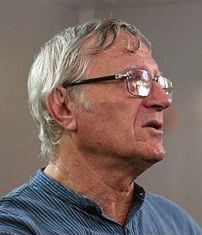
Prof. Felix Aharonian
(Dublin Institute for Advanced Studies, Ireland and
Max Planck Institute for Nuclear Physics, Heidelberg, Germany)
The research activity of Felix Aharonian has covered a wide range of astrophysical and astronomical fields including the basic theory of radiation processes in relativistic plasmas, theoretical and observational studies concerning the origin of cosmic rays both of Galactic and extragalactic nature, and extensive observational work in gamma-ray astronomy.
As for the theoretical work mostly related to his early research career, we stress his exact derivation of the kernel of the Compton scattering in the general relativistic case, the radiation spectrum of electron-positron plasmas and the “blue shift” of the corresponding annihilation line, the formation of a Maxwellian tail in thermal plasmas, the energy spectrum from pairs with photon- photon interactions and the first detailed calculations of their cascades in radiation fields. Recently he and his colleagues have developed, for the first time, a complete theory of magnetic bremsstrahlung of relativistic particles in a highly turbulent medium, the so-called jitter radiation.
It is to be highly appreciated how the nominee has systematically focused his theoretical expertise onto the interpretations of extreme astrophysical conditions as found particularly in young Supernova Remnants and Pulsars, and in Active Galactic Nuclei with relativistic jets, all sites of choice for efficient particle acceleration and ensuing high energy phenomena.
One specific focus of his research is constituted by the century-old issue concerning the origin of Cosmic Rays, a field in which Felix Aharonian is a recognized authority. We stress in particular his studies concerning the acceleration of Cosmic Rays to above 100 TeV in Supernova Remnants within our Galaxy, the propagation of the high energy tail in the intergalactic space, and the prediction of gamma rays from giant molecular clouds as Cosmic Ray barometers, In fact, Felix Aharonian was among the first to recognize the great potentiality of high energy gamma-ray observations from sources that qualify as likely accelerators of Cosmic Rays. The validity of his anticipations is now well established and his latest contribution has just been published (Aharonian et al. 2012, Nature, Abrupt acceleration of a 'cold' ultrarelativistic wind from the Crab pulsar, 432, 507).
In order to scale up the efficiency for the detections of very high energy gamma rays sources, Felix Aharonian has pioneered the “stereoscopic atmospheric Cherenkov imaging technique” by neatly formulating the basic principles (Aharonian et al. 1993, Experimental Astronomy, The system of imaging atmospheric Cherenkov telescopes – The new prospects for VHE gamma ray astronomy, 2, 331) and assessing the expected performance of Cherenkov telescope arrays. These ideas have been put to test first with the prototypical array HEGRA at La Palma (Canary Islands), and then with the H.E.S.S. (High Energy Stereoscopic System) array in Namibia. The very successful observations carried out under his coordination have in fact opened a new window in the observation of the Universe.
The about 150 papers detail the many exciting results of such observations conducted by the HERA and H.E.S.S. collaborations of which he is a leading member. Here we just mention that a most interesting result, with important cosmological implications, is the derivation of an upper limit on the background light at optical/near IR wavelengths which severely constrains the contributions from sources other than galaxies. All these achievements have been recognized by two distinguished international science awards assigned to the H.E.S.S. collaboration, the 2006 EU Descartes Prize and 2010 Rossi Prize (A.Aharonian, W.Hofmann and H.Voelk). The innovation of the “stereoscopic” approach, also adopted by other instruments such as MAGIC and VERITAS, is at the heart of the future Cherenkov Telescope Array (CTA), a project involving a large international collaboration.
His overall scientific production includes about 400 articles in peer reviewed journals. In addition to those already mentioned in square brackets, we have selected a limited number that are highly significant, well cited and representative of his wide research interests as outlined above:
- High energy electrons and positrons in cosmic rays as an indicator of the existence of a nearby cosmic tevatron, Astronomy and Astrophysics, 294, L41 (1995): Aharonian F. A., Atoyan, A. M., Voelk H. J.
- TeV gamma rays from BL Lac objects due to synchrotron radiation of extremely high energy protons, New Astronomy, 5, 377 (2000): Aharonian F. A.
- Proton-synchrotron radiation of large-scale jets in active galactic nuclei, Monthly Notices of the Royal Astronomical Society, 332, 215 (2002): Aharonian F. A.
- Fermi Bubbles: Giant, Multibillion-Year-Old Reservoirs of Galactic Center Cosmic Rays, Physical Review Letters, 106, 101102 (2011): Crocker R. M., Aharonian F.
- High-energy particle acceleration in the shell of a supernova remnant, Nature, 432, 75 (2004): Aharonian, F.A. et al.
- Very high energy gamma rays from the direction of Sagittarius A*, Astronomy and Astrophysics, 425, L13 (2004), Aharonian, F.A. et al.
- High-Energy Gamma Rays from the Massive Black Hole in the Galactic Center, The Astrophysical Journal, 619, 306 (2005): Aharonian F.A., Neronov A.
- A low level of extragalactic background light as revealed by γ-rays from blazars, Nature, 440, 1018 (2006): Aharonian, F.A. et al.
- Discovery of very-high-energy γ-rays from the Galactic Centre ridge, Nature 439, 695 (2006): Aharonian, F.A. et al.
- The H.E.S.S. Survey of the Inner Galaxy in Very High Energy Gamma Rays, The Astrophysical Journal, 636, 777 (2006) : Aharonian, F A. et al.
In addition, he is the author of a well-known monograph on “Very high energy cosmic gamma radiation: a crucial window on the extreme Universe” (2004, World Scientific).
Apart from gamma ray astronomy he is also involved in major experiments in other domains such as KM3NeT (a high energy neutrino project in the Mediterranean Sea), ROTSE (a network of optical telescopes for the GRBs afterglow) and ASTRO-H (a major future JAXA-NASA-ESA X- ray mission).
Felix Aharonian is an outstanding astrophysicist whose many contributions to high-energy astrophysics and to the physics of cosmic accelerators are widely recognized. He is a rare example of a scientist that combines a deep understanding of both the theoretical and observational aspects, and whose basic ideas and intuitions have revolutionized the field of ground-based gamma ray astronomy and opened a new window for the observations of extremely energetic cosmic phenomena.
|

Prof. Igor Karachentsev
(Special Astrophysical
Observatory, Russia)
|

Prof. Brent Tully
(Institute of Astronomy,
University of Hawaii, USA)
|
|
Working separately and together, Igor Karachentsev and Brent Tully have been primarily responsible for our increasingly nuanced understanding of the structure of the local universe. They have identified and mapped the nearby filaments and voids. Through their work it has become evident that the random motions of galaxies on few megaparsec scales are much lower than had been theoretically anticipated. Not more than half the expected matter density of the universe, dark and baryonic, lies in bound halos.
The work of these two researchers has involved discovering galaxies, locating them in three-dimensions with distance measurements, and parsing their peculiar velocities from the cosmic expansion. Nearest home the picture has become quite detailed. Karachentsev and his wife provided a critical initial input with their all-sky search and inventory of dwarf galaxies. Follow up begun by Karachentsev and joined by Tully has involved imaging with Hubble Space Telescope and acquisition of accurate distances with the tip of the red giant branch methodology, now of 350 galaxies. This research has revealed that almost all galaxies lie in groups, including groups of only dwarfs, that dark matter is required to bind the groups, but that the sum of dark matter in groups falls considerably short of the amount anticipated from cosmological studies on large scales. Their research confirms that there is a clear deficiency in the numbers of dwarfs compared with the standard cold dark matter hierarchical clustering paradigm. The three dimensional information gives clarity to environmental factors affecting galaxy morphologies. Most but not all gas-depleted galaxies are secondary systems in collapsed halos.
Random motions within the Local Sheet that we live in are remarkably small and emerging Hubble Space Telescope data is confirming that random motions in adjacent structures are similarly modest. Nonetheless galaxies can experience large collective streaming motions. A dramatic example brought clearly to light by the tip of the red giant branch distances of Karachentsev and Tully are the motions outward from the Local Void. The Local Sheet is a wall bounding and in expansion from the Local Void at a velocity of 260 km/s. A significant part of our peculiar velocity reflected in the cosmic microwave background dipole is motion away from the Local Void.
Brent Tully made a well known contribution to cosmology with the discovery, with Richard Fisher, of the correlation between galaxy luminosity and rotation rate. For two decades this correlation provided the best way to measure galaxy distances, hence peculiar velocities, on scales of tens to hundreds of megaparsecs. Today, while there are competitive methods, the Tully-Fisher Relation provides the largest samples of galaxy distances. The 2013 Cosmicflows-2 compendium by Tully and a team including Karachentsev contains distances and peculiar velocities for over 8,000 galaxies. Cosmicflows-2 combines information from diverse methodologies to provide a sample of galaxy distances with dense and accurate coverage locally yet one that extends with limited coverage to 0.1z.
Brent Tully and Richard Fisher are also the authors of the Nearby Galaxies Atlas, to this day the only substantial atlas on paper of the nearby universe. In recent years many astronomers have contributed to redshift surveys that extend our collective knowledge of local structure. The Cosmicflows-2 distance compendium gives the physical space location of galaxies in redshift surveys and provides measures of their deviant motions. These motions are assumed to be caused by density perturbations. Twenty years ago, when the theoretical community favored a universe model with closure density in matter, Tully and collaborators Ed Shaya and James Peebles argued from observed kinematics that the density of matter is much lower than the requirement for closure, in line with present estimates. Tully and others also argued that measurements of the Hubble Constant, combined with cosmic age estimates, favored a positive value of the Cosmological Constant, presaging the evidence from supernovae later in the decade. Nowadays using the much better data of the Cosmicflows-2 sample, Tully participates in a program of Wiener Filter reconstructions of three-dimensional velocity and density fields that extend to 200 Mpc. Our galaxy is found to be part of a basin of attraction with inflowing velocity streams with an extent of 80 Mpc radius. Yet this entire region is only an appendage of a larger attractor 200 Mpc away.
Karachentsev and Tully are part of a small community doing `local cosmology’. The extremely low velocities on small scales, the dearth of dwarf galaxies, and the apparent emptiness of voids are responses to the nature of dark energy and dark matter. The accumulating evidence may favor “warm” over “cold” dark matter. There is also much to be learned from environmental factors in the lives of nearby galaxies. When did the oldest stars form? Are there traces of merger histories, of gas acquisition and depletion?
On larger scales galaxy streaming is an impressive feature. Our galaxy has a motion of over 600 km/s in the reference frame of the cosmic microwave background. After accounting for velocities of 260 km/s expansion from the Local Void and 180 km/s attraction toward the Virgo Cluster, there remains 450 km/s to explain. Attractors including the Norma and Centaurus clusters at 50 Mpc and the Shapley complex at 200 Mpc must be important. Whether these attractors fully account for our motion or not is one of the most important unsettled questions in cosmology. It is through the detailed mapping and accumulation of information on galaxy motions as with Karachentsev’s Updated Nearby Galaxy Catalog and Tully’s Cosmicflows series that these important questions will be answered.
|
|